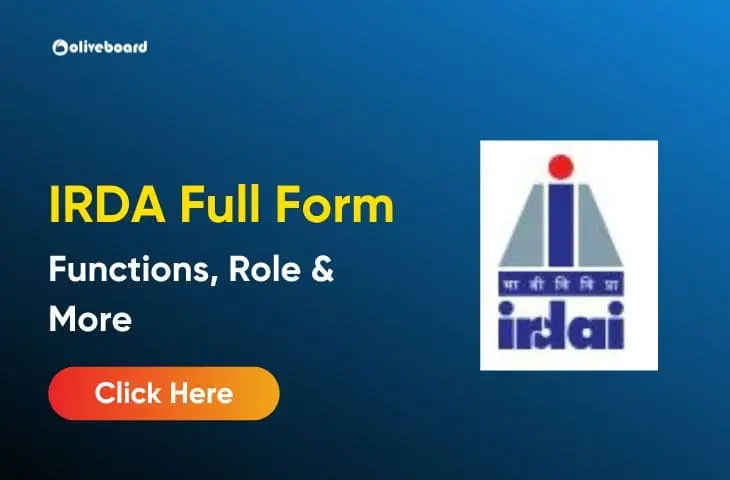IRDA Full Form
IRDA Full Form is Insurance Regulatory and Development Authority. The Insurance Regulatory and Development Authority of India (IRDAI) is the regulatory body responsible for overseeing the insurance sector in India. Its main role is to protect policyholders’ interests and promote the expansion of the insurance market.
What is IRDA?
From years, people are looking for the ways to protect themselves from the risks associated with the insurance sector. If we look at the dictionary meaning of Insurance then it is defined as a system in which an organization offers financial compensation for specific losses, damages, illnesses, or deaths in exchange for a set premium. Initially, the insurance sector in India was regulated by the government. However, with the growth of the industry, a separate authority was needed to oversee and regulate the market. This led to the establishment of the IRDA.
Functions of IRDAI
The IRDAI’s main objective is to implement the guidelines outlined in the Insurance Act. Some of its core functions include:
- Protecting Policyholders: Ensuring that policyholders receive fair treatment and protection.
- Regulating the Insurance Industry: Setting rules and ensuring that companies operate in a financially sound and transparent manner.
- Formulating Regulations: Drafting and updating regulations to maintain clarity and consistency in the insurance market.
Role and Importance of IRDAI in the Insurance Sector
Insurance in India dates back to the 1800s, and the sector has seen continuous growth. With the establishment of IRDAI, various laws were streamlined, and amendments were introduced to protect policyholders. Some key roles of the IRDAI are:
- Safeguarding Policyholders: Protecting their interests and ensuring they receive fair treatment.
- Promoting Growth: Supporting the organized growth of the insurance sector, making it accessible and beneficial to the public.
- Ensuring Fair Practices: Overseeing fair practices and the financial stability of insurance companies.
- Faster Claims Settlement: Ensuring that genuine claims are processed and settled without unnecessary delays.
- Grievance Redressal: Providing a proper system for addressing and resolving policyholder complaints.
- Preventing Malpractices: Monitoring and preventing fraud and unethical practices in the industry.
- Transparency and Integrity: Promoting fairness and ensuring companies operate with transparency in the financial markets.
- Maintaining Financial Stability: Setting high standards for financial stability and management within the insurance industry.
What is IRDA Exam?
To recruit Assistant Managers from all over India, IRDA conducts a recruitment process. This exam is conducted annually wherein the candidates fill up the application forms after checking the complete eligibility. If they are eligible, they pay the application fee and successfully submit the application form. Thereafter, the candidates go through a three tier selection process which consists of prelims exam, mains exam and interview. The IRDAI Assistant Manager Notification 2024 has already been released.
Types of Insurance Regulated by IRDAI
Insurance in India is broadly divided into two categories: life insurance and general (or non-life) insurance.
Life Insurance: Covers policies related to life protection, offering financial security in case of death or other life-related risks.
- Term Plans: Offers pure life coverage for a specified term.
- ULIP (Unit Linked Insurance Plan): Combines life insurance with investment opportunities.
- Endowment: Provides a lump sum amount on policy maturity or death.
- Money-Back: Offers periodic payouts during the policy term.
- Retirement: Plans to secure financial stability during retirement.
General Insurance: Includes various policies such as health insurance, vehicle insurance, home insurance, commercial insurance, travel insurance, and others.
- Health Insurance: Covers medical expenses and healthcare costs.
- Motor/Vehicle Insurance: Protects against damages to vehicles and liabilities.
- Travel Insurance: Safeguards against unexpected events during travel.
- Home Insurance: Covers damages to the insured property.
- Gadgets Insurance: Protects electronic devices from damages and theft.
- Property Insurance: Safeguards various types of properties against risks.
Apart from these, the IRDAI is responsible for granting licenses to insurance companies, resolving disputes between policyholders and insurers, and overseeing the general functioning of the insurance sector in India.
IRDA Full Form FAQs
The IRDA Full Form is Insurance Regulatory and Development Authority of India.
In Hindi, the IRDA Full Form is “बीमा निगरानी और विकास प्राधिकृति” (Bima Nigraani aur Vikas Pradhikriti), which translates to “Insurance Regulatory and Development Authority.”
IRDAI conducts a recruitment exam to appoint candidates on the position of Assistant Manager. This is a All India level exam for the eligible candidates.
Shri Debasish Panda is the chairman of IRDA. He joined IRDAI on 14th March 2022.
IRDA is a statutory or regulatory body formed under an Act of Parliament, i.e., IRDA Act, 1999 (IRDA Act, 1999) for overall supervision and development of the Insurance sector in India.
- SIDBI Grade B Books 2025, Get Subject Wise List
- SIDBI Grade B Notification 2025 Out, Apply for 26 Vacancies
- SIDBI Grade B Syllabus & Exam Pattern 2025, Download PDF
- SIDBI Grade B Eligibility 2025, Age, Qualification, Nationality
- SIDBI Grade B Apply Online 2025, Link Active Till 11 August
- SIDBI Grade B Preparation Strategy & Previous Exam Analysis

Hello there! I’m a dedicated Government Job aspirant turned passionate writer & content marketer. My blogs are a one-stop destination for accurate and comprehensive information on exams like Regulatory Bodies, Banking, SSC, State PSCs, and more. I’m on a mission to provide you with all the details you need, conveniently in one place. When I’m not writing and marketing, you’ll find me happily experimenting in the kitchen, cooking up delightful treats. Join me on this journey of knowledge and flavors!
